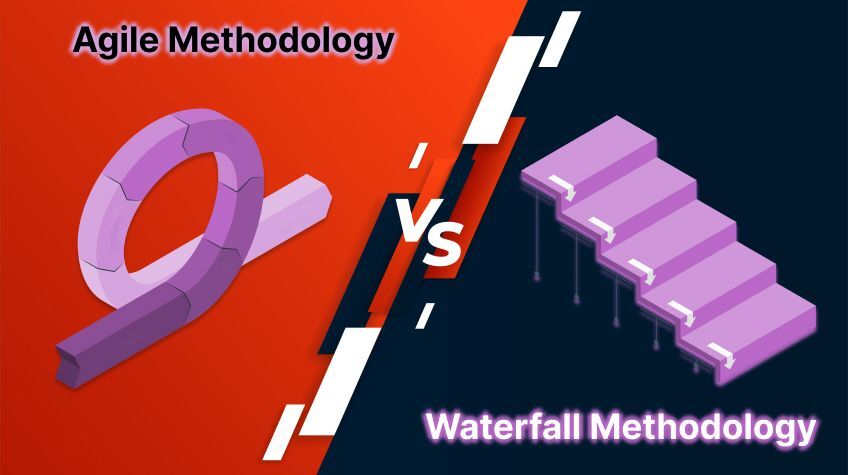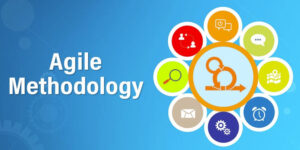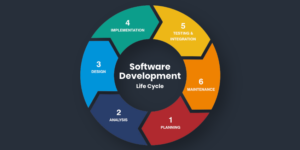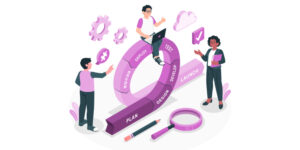
In today’s rapidly evolving software development landscape, choosing the right methodology is crucial for successful project execution. Agile and Waterfall are two prominent methodologies that offer distinct approaches to software development. This article aims to compare and contrast Agile vs Waterfall, shedding light on their characteristics, advantages, and disadvantages to help organizations make informed decisions.
Waterfall Methodology
The Waterfall methodology follows a sequential and linear approach to software development, often employed by software development agencies. It entails a series of distinct phases, including requirements gathering, design, implementation, testing, deployment, and maintenance. Each phase relies on the completion of the previous one before progressing further.
Advantages of Waterfall
One of the primary advantages of the Waterfall methodology is its emphasis on clear project scope and deliverables. With upfront planning and documentation, stakeholders have a well-defined understanding of the project requirements and expected outcomes. Additionally, Waterfall projects typically have well-defined milestones and deadlines, allowing for better project management. The comprehensive documentation produced during each phase ensures traceability and enables easy maintenance and future enhancements.
Disadvantages of Waterfall
Despite its advantages, the Waterfall methodology has some limitations. One of the major drawbacks is its limited flexibility for changes and iterations. Once a phase is completed, it is challenging and costly to make changes or accommodate new requirements. This lack of flexibility can lead to difficulties in adapting to evolving project needs. Late-stage changes can significantly impact timelines, budgets, and overall project success. Another downside is the limited customer involvement until the end of the project. This lack of continuous feedback can result in misalignments between the delivered product and customer expectations.
Agile Methodology
The Agile methodology takes an iterative and incremental approach to software development. It promotes adaptive planning, collaboration, and continuous delivery. Agile teams work in short iterations, known as sprints, and prioritize delivering working software at regular intervals.
Advantages of Agile
Agile methodologies offer several advantages. First and foremost, they provide flexibility and adaptability to changes. Agile teams welcome changes in requirements, leveraging an iterative approach to incorporate new insights and deliver value incrementally. Continuous customer involvement is a key tenet of Agile.
Customers actively participate in the development process, providing feedback and validating the evolving software. This close collaboration ensures a higher likelihood of meeting customer expectations. Another advantage is the early delivery of working software.
Agile projects aim to provide tangible results in each sprint, allowing stakeholders to see progress and make informed decisions.
Disadvantages of Agile
While Agile methodologies offer numerous benefits, they also come with certain challenges. Without proper control and governance, Agile projects can suffer from scope creep. Continuous changes and additions may lead to the expansion of project scope beyond the original plan, potentially impacting timelines and budgets.
Agile methodologies heavily rely on experienced team members and strong collaboration. The success of Agile projects is highly dependent on effective communication, self-organizing teams, and active participation from all stakeholders.
Additionally, Agile methodologies typically produce less documentation compared to Waterfall, which may require organizations to supplement with additional documentation for compliance or future reference.
Key Differences Between Agile vs Waterfall
There are significant differences between Agile and Waterfall methodologies that influence project outcomes.
In terms of project planning and execution, Waterfall methodologies focus on detailed upfront planning, where each phase follows the previous one in a linear manner. On the other hand, Agile methodologies embrace adaptive planning, allowing for adjustments and reprioritization based on evolving needs and feedback.
The approach to changes is another key distinction. Waterfall methodologies discourage changes once a phase is completed, as they can be costly and disrupt the planned schedule. In contrast, Agile methodologies actively accommodate changes throughout the development process, promoting flexibility and responsiveness to evolving requirements.
Customer involvement also differs significantly between the two methodologies. Waterfall methodologies often limit customer involvement until the end of the project, with minimal opportunities for feedback during the development process. Agile methodologies, on the other hand, prioritize continuous customer collaboration, seeking feedback and validation at every stage to ensure alignment with customer expectations. This approach is particularly valuable for an IT service company to deliver solutions that meet the evolving needs of their clients.
Regarding documentation, Waterfall methodologies produce extensive documentation at each phase, capturing detailed requirements, designs, and test plans. Agile methodologies, while still valuing documentation, focus more on delivering working software and maintaining lightweight documentation.
Similar Blog: Key Differences Between Agile and DevOps Methodologies
Choosing the Right Software Development Methodology
Selecting the appropriate methodology depends on various factors, including project size and complexity, customer involvement requirements, and team experience and collaboration capabilities.
For larger projects with well-defined requirements and limited changes, Waterfall may be suitable. It offers a structured approach and comprehensive documentation. However, for projects that require flexibility, frequent changes, and close customer collaboration, Agile is more appropriate.
It’s also important to note that organizations can adopt hybrid approaches or customize methodologies to suit their specific needs. Some projects may benefit from blending elements of Agile and Waterfall, leveraging the strengths of both methodologies.
Conclusion
In the dynamic world of software development, choosing the right methodology is critical to project success. Agile and Waterfall methodologies offer distinct approaches, each with its own set of advantages and disadvantages.
Waterfall provides structure and clarity, making it suitable for projects with well-defined requirements. However, it lacks flexibility and customer involvement until the late stages.
Agile, with its adaptive planning, continuous customer collaboration, and early delivery of working software, is ideal for projects requiring flexibility, adaptability, and customer engagement. However, it requires strong team collaboration and may need additional documentation.
By considering project requirements, customer involvement needs, and team capabilities, organizations can make informed decisions when selecting the most appropriate methodology. In some cases, a hybrid approach or customization of methodologies may be necessary to achieve optimal results.
In conclusion, understanding the characteristics, advantages, and disadvantages of Agile and Waterfall methodologies enables organizations to make informed choices and effectively manage software development projects. By selecting the right methodology and embracing its principles, organizations can enhance productivity, deliver high-quality software, and meet customer expectations in today’s rapidly evolving software landscape.
Author Bio
Jane Hart is a Head of Digital Marketing & a technical writer at Selected Firms. She has 7+ Years of experience in developing content and new ideas for presentation for company websites, blogs, white papers, business collaterals, and case studies. Experience in writing, rephrasing, proofreading, curating, editing, and managing content for both B2C and B2B clients. Knowledge of best SEO practices to create content as per SEO requirements for better search engine performance.






